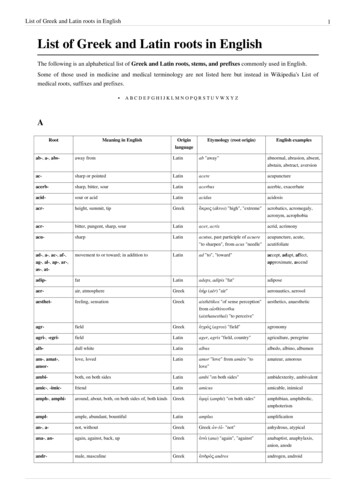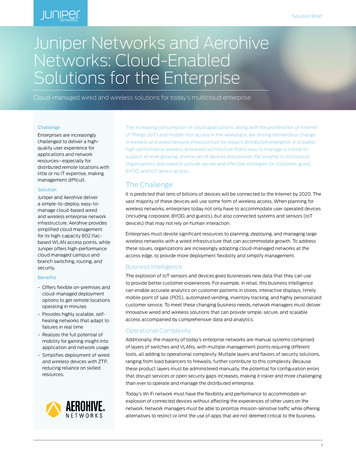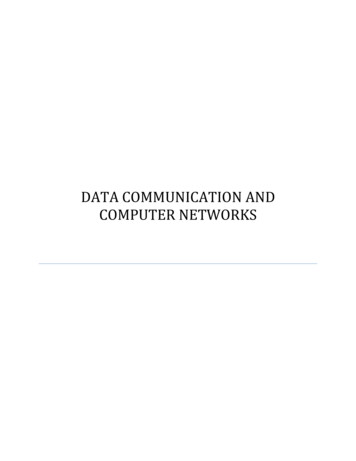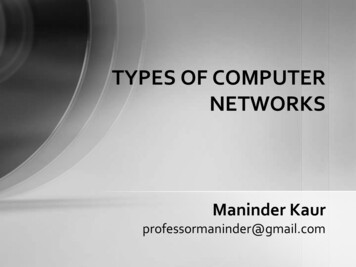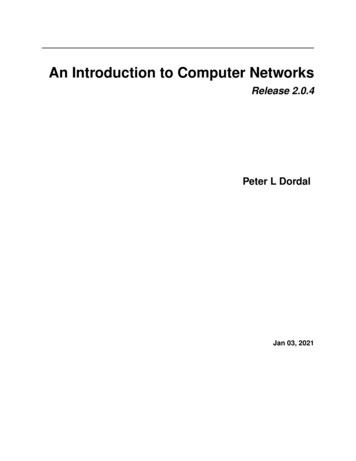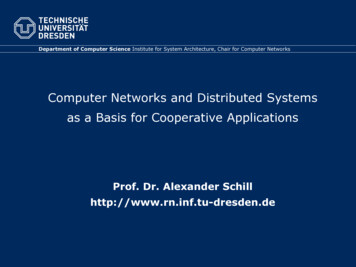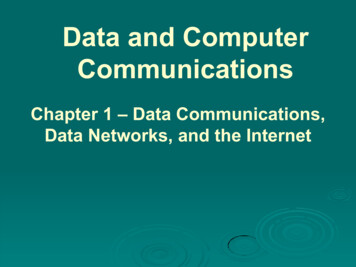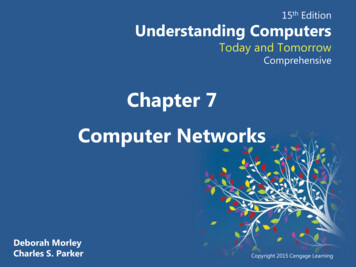
Transcription
15th EditionUnderstanding ComputersToday and TomorrowComprehensiveChapter 7Computer NetworksDeborah MorleyCharles S. ParkerCopyright 2015 Cengage Learning
Learning Objectives1. Define a computer network and its purpose.2. Describe several uses for networks.3. Understand the various characteristics of a network, such astopology, architecture, and size.4. Understand characteristics about data and how it travelsover a network.Understanding Computers: Today and Tomorrow, 15th Edition2
Learning Objectives5. Name specific types of wired and wireless networking mediaand explain how they transmit data.6. Identify the most common communications protocols andnetworking standards used with networks today.7. List several types of networking hardware and explain thepurpose of each.Understanding Computers: Today and Tomorrow, 15th Edition3
Overview This chapter covers:– Computer network is defined– Common networking and communications applications– Networking concepts and terminology– Technical issues related to networks, including generalcharacteristics of data transmission, and types oftransmission media in use today– Explanation of the various communications protocols andnetworking standards– Various types of hardware used with a computer networkUnderstanding Computers: Today and Tomorrow, 15th Edition4
What Is a Network? Network– A connected system of objects or people Computer network– A collection of computers and other hardware devicesconnected together so users can share hardware,software, and data, and electronically communicate Computer networks are converging with telephone and othercommunications networks Networks range from small private networks to the Internet In most businesses, computer networks are essentialUnderstanding Computers: Today and Tomorrow, 15th Edition5
Inside the Industry BoxWireless Power– Powers/recharges devices via wireless signals andmagnetic induction– Wireless Power Consortiumsupports the Qi standard– Can use built-in orexternal charging receiver– May be built into walls,homes, cars, garage floors,etc. in the futureUnderstanding Computers: Today and Tomorrow, 15th Edition6
Networking Applications The Internet– Largest computer network in the world Telephone Service– POTS Network One of the first networks Still used today to provide telephone service to landlinephones– Mobile Phones (wireless phones) Use a wireless network for communicationsUnderstanding Computers: Today and Tomorrow, 15th Edition7
Networking Applications Cellular (cell) Phones– Must be within range of cell tower to function Dual-mode Phones– Allow users to make telephone calls using morethan one communications network– Cellular/Wi-Fi dual-mode phones can switchseamlessly between the Wi-Fi network and acellular network Satellite Phones– Communicate via satellite technology– Most often used by individuals such as soldiers,journalists, wilderness guides, and researchersUnderstanding Computers: Today and Tomorrow, 15th Edition8
Networking ApplicationsUnderstanding Computers: Today and Tomorrow, 15th Edition9
Networking Applications Television and Radio Broadcasting– Still used to deliver TV and radio content to the public– Other networks involved with television content deliveryare cable TV networks, satellite TV networks, and privateclosed-circuit television systems Global Positioning System (GPS) Applications– Uses satellites and a receiver to determine the exactgeographic location of the receiver– GPS receivers Commonly used by individuals to determine theirgeographic locationUnderstanding Computers: Today and Tomorrow, 15th Edition10
Networking Applications GPS receivers– Used on the job by surveyors, farmers, and fishermen– Used to guide vehicles and equipment– Used by the military to guide munitions and trucks, and totrack military aircraft, ships, and submarinesUnderstanding Computers: Today and Tomorrow, 15th Edition11
Networking Applications Monitoring Systems– Use networking technology to determine the currentlocation or status of an object RFID-based Systems– Monitor the status of objects GPS-based Monitoring Systems– Monitor the physical location of objects– Vehicle and child monitoring systems Electronic Medical Monitors– Home healthcareUnderstanding Computers: Today and Tomorrow, 15th Edition12
Networking Applications Sensors are used in some monitoring systems– Sensor networks– Home automation(smart thermostats,etc.)Understanding Computers: Today and Tomorrow, 15th Edition13
Networking Applications Multimedia Networking– Distributing digital multimedia content, typically via ahome network– Necessary networking capabilities are often built intodevices being used– Might need to use multimedia networking device such as adigital media receiver or digital media streamer– Placeshifting Content Allows individuals to view multimedia content at amore convenient location, i.e., SlingboxUnderstanding Computers: Today and Tomorrow, 15th Edition14
Networking Applications Videoconferencing, Collaborative Computing, andTelecommuting– Videoconferencing Use of computers, video cameras, microphones, andnetworking technologies to conduct face-to-facemeetings over a network– Telepresence Videoconferencing A setup that more closely mimics a real-time meetingenvironmentUnderstanding Computers: Today and Tomorrow, 15th Edition15
Networking Applications– Collaborative Computing (workgroup computing) Enables individuals to work together on documents andprojects– Telecommuting Individuals work from a remote location (usually home)and communicate with their places of business andclients using networking technologies Allows for employee flexibilityUnderstanding Computers: Today and Tomorrow, 15th Edition16
Networking Applications Telemedicine– Use of networking technology to provide medicalinformation and services– Remote monitoring and consultations– Remote diagnosis– Telesurgery Robot assisted surgery where doctor’s physical locationis different from the patient’s and robot’s Will be needed for long-term space explorationUnderstanding Computers: Today and Tomorrow, 15th Edition17
Networking ApplicationsUnderstanding Computers: Today and Tomorrow, 15th Edition18
Network Characteristics Wired vs. Wireless Networks– Wired A network in which computers and other devices arephysically connected to the network with cables Found in schools, businesses, and government facilities– Wireless A network in which computers and other devices areconnected to the network without physical cables Data is typically sent via radio waves Found in homes, schools, and businessesUnderstanding Computers: Today and Tomorrow, 15th Edition19
Trend BoxStadium Wireless Networks– Professional sports venues are increasingly includingwireless access and other technology– Free Wi-Fi– Seat tablet holders– In-game apps– HD video boardsUnderstanding Computers: Today and Tomorrow, 15th Edition20
Network Characteristics Network Topologies: Indicate how the devices in the networkare arranged– Star Networks All networked devices connect to a centraldevice/server If the central device fails, the network cannot work– Bus Network Uses a central cable to which all network devicesconnect– Mesh network Multiple connections among the devices on thenetwork so that messages can take any of severalpossible pathsUnderstanding Computers: Today and Tomorrow, 15th Edition21
Network CharacteristicsUnderstanding Computers: Today and Tomorrow, 15th Edition22
Network Characteristics Network Architectures– Client-Server Networks Client– Computer or other device on the network thatrequests and utilizes network resources Server– Computer dedicated to processing client requestsUnderstanding Computers: Today and Tomorrow, 15th Edition23
Network CharacteristicsUnderstanding Computers: Today and Tomorrow, 15th Edition24
Network Characteristics– Peer-to-Peer (P2P) Networks Central server is not used All computers on the network work at the samefunctional level Users have direct access to the computers and devicesattached to the network Less complicated and less expensive to implement thanclient-server networks Internet P2P Computing– Content is exchanged over the Internet directlybetween usersUnderstanding Computers: Today and Tomorrow, 15th Edition25
Network Characteristics Network Size and Coverage Area– Personal Area Networks (PANs) Connect an individual’s personal devices– Devices must be physically located close together– Local Area Networks (LANs) Connect devices located in a small geographic area– Metropolitan Area Networks (MANs) Cover a metropolitan area such as a city or county– Wide Area Networks (WANs) Cover a large geographic area Two or more LANs connected togetherUnderstanding Computers: Today and Tomorrow, 15th Edition26
Network Characteristics– Intranets and Extranets Intranet– Private network designed to be used by anorganizations’ employees; set up like the Internet Extranet– Company network accessible by authorizedoutsiders– Virtual Private Networks (VPNs) Private, secure path over the Internet that providesauthorized users a secure means of accessing a privatenetwork via the Internet Uses tunneling and special encryption technologyUnderstanding Computers: Today and Tomorrow, 15th Edition27
Quick Quiz1. Which of the following describes a group of private secure paths setup using the Internet?a. VPNb. WANc. WSN2. True or False: With a bus network, all devices are connected directlyto each other without the use of a central hub or cable.3. A private network that is set up similar to the World Wide Web foruse by employees of a specific organization is called a(n).Answers:1) a; 2) False; 3) intranetUnderstanding Computers: Today and Tomorrow, 15th Edition28
Data Transmission Characteristics Bandwidth– The amount of data that can betransferred in a given period of time– Measured in bits per second (bps),Kbps (thousands), Mbps (millions ), orGFbps (billions) Analog vs. Digital Signals– Data represented by two discretestates: 0s and 1s– Conventional telephone systems useanalog signals Represent data with continuouswavesUnderstanding Computers: Today and Tomorrow, 15th Edition29
Data Transmission Characteristics Transmission Type and Timing– Serial Data sent one bit at a time,one after another, along asingle path– Parallel Data sent at least one byte attime with each bit in the bytetaking a different pathUnderstanding Computers: Today and Tomorrow, 15th Edition30
Data Transmission Characteristics Synchronous Transmission– Blocks of data are transferred at regular, specified intervals– Most data transmissions within a computer and over anetwork are synchronous Asynchronous Transmission– Data is sent when ready without being synchronized– Start bits and stop bits used to identify the bits that belongin each byte Isochronous Transmission– Data sent at the same time as other, related, dataUnderstanding Computers: Today and Tomorrow, 15th Edition31
Data Transmission CharacteristicsUnderstanding Computers: Today and Tomorrow, 15th Edition32
Data Transmission Characteristics Simplex Transmission– Data travels in a single direction only Half-Duplex Transmission– Data travels in either direction but only one way at a time Full-Duplex Transmission– Data travels in both directions at the same timeUnderstanding Computers: Today and Tomorrow, 15th Edition33
Data Transmission Characteristics Delivery Method– Circuit-Switching Dedicated path over a network is established betweensender and receiver; all data follows that path– Packet-Switching Messages are separated into small units called packetsand travel along the network separately; packets arereassembled once destination is reached– Broadcasting Data is sent out to all other nodes on the network andretrieved only by the intended recipient; primarily usedwith LANsUnderstanding Computers: Today and Tomorrow, 15th Edition34
Data Transmission CharacteristicsUnderstanding Computers: Today and Tomorrow, 15th Edition35
Networking Media Wired Networking Media– Twisted-Pair Cable Pairs of insulated wires twisted together Used for telephone and network connections (LANs)– Coaxial Cable Thick center wire surrounded by insulation Used for computer networks and cable televisiondelivery– Fiber-Optic Cable Utilizes hundreds of thin transparent clear glass orplastic fibers over which lasers transmit data as light Used for high-speed communicationsUnderstanding Computers: Today and Tomorrow, 15th Edition36
Networking MediaUnderstanding Computers: Today and Tomorrow, 15th Edition37
Networking Media Wireless Networking Media– Data is sent through the airwaves using radio signals– The Electromagnetic and Wireless Spectrum Radio frequencies are assigned by the FCC and aremeasured in hertz (Hz) The electromagnetic spectrum is the range of commonelectromagnetic radiation (energy) Different parts of the spectrum have differentproperties, which make certain frequencies moreappropriate for certain applicationsUnderstanding Computers: Today and Tomorrow, 15th Edition38
Networking MediaUnderstanding Computers: Today and Tomorrow, 15th Edition39
Networking Media Frequencies assigned to an application usually consist of arange of frequencies to be used as needed Most wireless networking applications use frequencies in theRF band at the low end of the spectrum—up to 300 GHz– Often called the wireless spectrum The 900 MHz, 2.4GHz, 5 GHz, and 5.8 GHz frequencies arewithin an unlicensed part of the spectrum and can be used byany product or individual– Cordless landline phones, garage door openers,Wi-Fi, WiMAX, and BluetoothUnderstanding Computers: Today and Tomorrow, 15th Edition40
Networking Media Cellular Radio Transmissions– Use cellular towers within honeycomb-shaped zones calledcells– Calls are transferred from
Name specific types of wired and wireless networking media and explain how they transmit data. 6. Identify the most common communications protocols and networking standards used with networks today. 7. List several types of networking hardware and explain the purpose of each. Understanding Computers: Today and Tomorrow, 15th Edition 3 . Overview This chapter covers: –Computer network File Size: 1MBPage Count: 79
